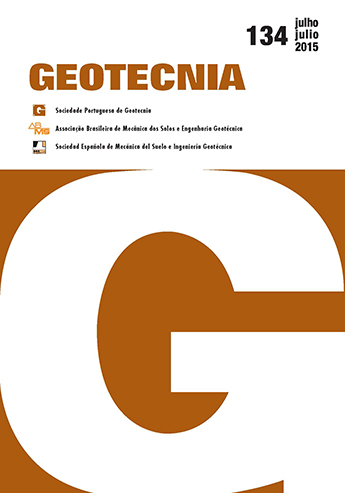Slope stability study of São Luís mine located in Catas Altas/MG combining GIS and usual investigation methods
DOI:
https://doi.org/10.24849/j.geot.2015.134.06Keywords:
Slope stability, Stereograms, Limit equilibriumAbstract
Analysis methods of slope stability are highly developed and consolidated in Engineering Geology. In addition, the application of GIS (Geographic Information System) tools has been intensified in all fields of technical-scientific knowledge. In this context, this study aimed to develop an approach to characterize the stability of mining slopes combining GIS techniques and traditional methods of geological geotechnical analysis. The investigation was developed in two scales of work: firstly, a semi regional characterization using GIS and thematic maps and, secondly, a detailed analysis, which used stereograms and limit-equilibrium. The semi-regional characterization allowed an understanding of the area surrounding the mine, through parameters such as slope, curvature and direction of slope. The stereogram analyses indicate various situations of instability whose features are identified in the field, confirming the susceptibility to these types of rupture. Similarly, the limit equilibrium analyses showed lower safety factors for small slides, which affected only a few slopes.
Downloads
References
Alkmim, F.F.; Marshak, S. (1998). Transamazonian Orogeny in the Southern São Francisco Craton Region, Minas Gerais, Brazil: evidence for Paleoproterozoic collision and collapse in the Quadrilátero Ferrífero. Precambrian Research, v.90, pp. 29-58.
Geoestrutural (2005). Complexo Fazendão Mina São Luís Tamanduá-Almas. Análises de estabilidade dimensionamento dos taludes. Relatório técnico interno. Catas Altas, MG. 90 p.
Goodman, R.E. (1989). Introduction to rock mechanics. 2nd ed., John Wiley & Sons, New York. 562p. Hoek, E.; Bray, J.W. (1981). Rock Slope Engineering. Institute of Mining and Metallurgy, London.
Lopes, A.P.R. (2007). Mapeamento do potencial de instabilização de taludes rodoviários usando SIG e seções geológico-geotécnicas de campo com aplicação na rodovia SP-310. Dissertação (Mestrado em Geotecnia) Escola de Engenharia de São Carlos, Universidade de São Paulo, São Carlos, 138p.
Moraes, M.A.S. (1985). Reconhecimento de fácies sedimentares em rochas metamórficas da região de Ouro Preto, Minas Gerais. In: SBG, Simp. Geol. Minas Gerais, 3. Belo Horizonte, Anais, pp. 84-93. (Boletim 5).
Reis, R.C. (2010). Estudo de estabilidade de taludes da mina de Tapira – MG. Dissertação (Mestrado em Geotecnia) – NUGEO Universidade Federal de Ouro Preto, 95p.
Renger, F.E.; Suckau, V.E.; Silva, R.M.P. (1993). Sedimentologia e análise de bacia da Formação Moeda, Quadrilátero Ferrífero, Minas Gerais, Brasil, In: Simpósio de Geologia de Minas Gerais, 7. Belo Horizonte: 1993. Anais. Belo Horizonte, SBG:1993, pp.41-45.
Silva, A.B. (1999). Sistemas de Informações Geo-referenciadas. Editora da Unicamp. Campinas. 250p.
Vaz, L.F. (1996). Classificação Genética dos Solos e dos Horizontes de Alteração de Rocha em Regiões Tropicais. Solos e Rochas, São Paulo. 19 (2), pp. 117-136.




